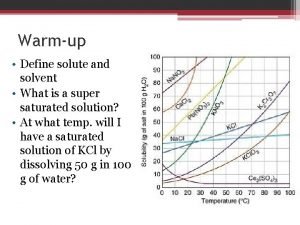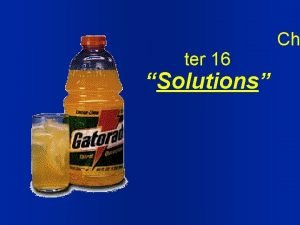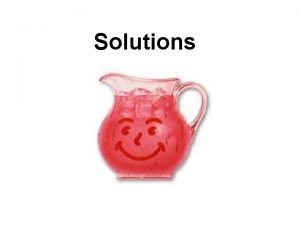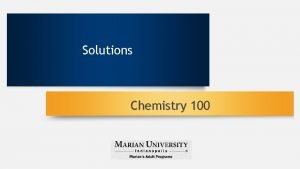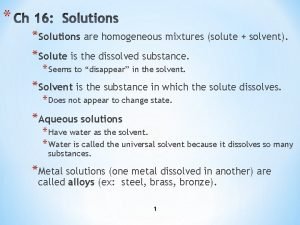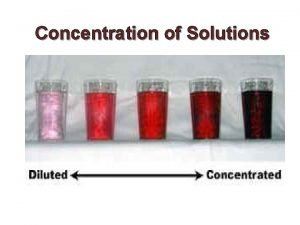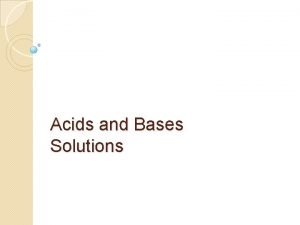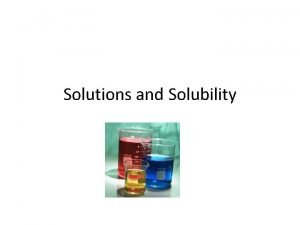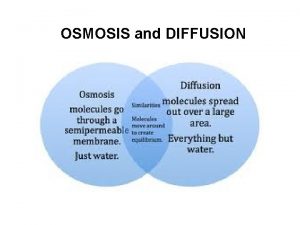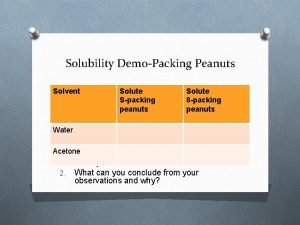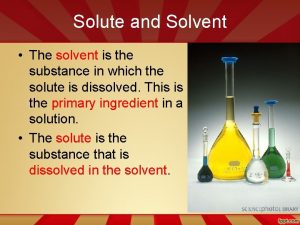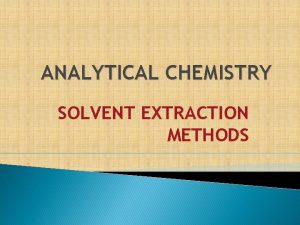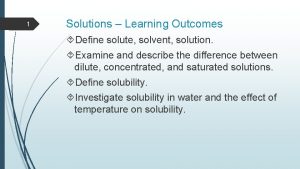Solutions Details Making a solution u Solvent solute












- Slides: 12

Solutions Details

Making a solution u Solvent, solute, and something to contain both. u Factors that affect solvation – Agitation – Temperature of solvent/solution – Surface area of solute

Degrees of saturation u Saturated: holds maximum amount of solute in given solvent at constant temperature and pressure u Solubility: the amt. of solute that dissolves in a given solvent at a specified temperature and pressure to give a saturated solution – Frequently given as grams/liter

More on saturation u If a solution contains less than the saturation amount of solute, it is called unsaturated u If you have a saturated solution, and cool if slowly, you can produce a supersaturated solution, which hold more solute than it “should” be able to. Crystallization will occur if a suitable seed is provided.

Liquid Solutions u Two liquids are miscible if they dissolve in each other in all proportions – The liquid in higher amount is considered the solvent u Liquids that are insoluble in each other are immiscible

Solubility u Factors – Temperature: as temperature increases: u most solids are more soluble u Most gases are less soluble – Pressure: only affects gases: u Henry’s law: S 1/P 1 = S 2/P 2 u As the pressure above the liquid increases, the solubility of the gas increases.

Concentration: molarity u Molarity (M) = mol solute/lit solution u Dilutions: (molarity)(volume) = mol

Other calculations of concentration u Molality – m= moles solute/kg solvent

Concentration: Percent solutions u% volume: – vol. solute/vol. soln. · 100% u% mass: – Mass solute/mass soln. · 100%

Colligative Properties of Solutions u Vapor-pressure reduction – This occurs because the solute causes there to be different intermolecular attractions than would exist in pure solvent…ionic compounds, which dissociate, have a greater effect than non-dissociating solutes, such as sugar. – The decrease in vapor pressure is proportional to the amt. of solute present in the solution

Colligative Properties of Solutions u Freezing-point depression – The amount of lowering of a freezing point due to the same disruption and/or attractions of a solute in a solvent – Again, proportional to amount – Think about the salting of roads and sidewalks!

Colligative Properties of Solutions u Boiling point elevation – Since the addition of a nonvolatile solute lowers the vapor pressure, this means that it takes more energy for the solution to reach the boiling point – Again, the magnitude of the elevation is proportional to the amt. of solute dissolved in the solution
 Define solute and solvent
Define solute and solvent Solute vs solvent
Solute vs solvent Is a solution a homogeneous mixture
Is a solution a homogeneous mixture Volume of solute divided by volume of solution * 100
Volume of solute divided by volume of solution * 100 Solute vs solvent
Solute vs solvent Quizlet
Quizlet A homogeneous mixture of a solute and solvent
A homogeneous mixture of a solute and solvent Solute-solvent combinations
Solute-solvent combinations What is solvent in science grade 7
What is solvent in science grade 7 Solute vs solvent
Solute vs solvent Solute
Solute Circle the solute and underline the solvent
Circle the solute and underline the solvent Sweet tea solute and solvent
Sweet tea solute and solvent
